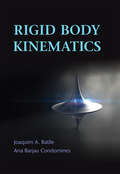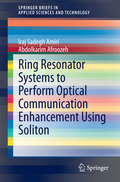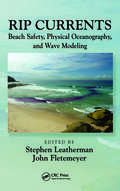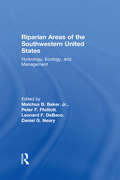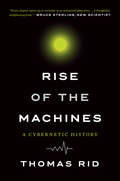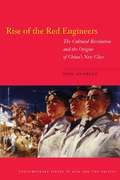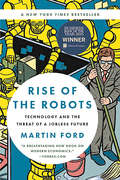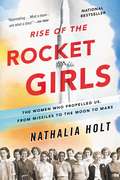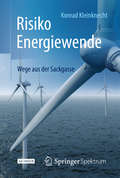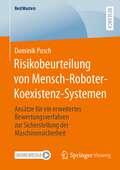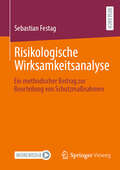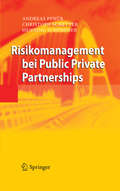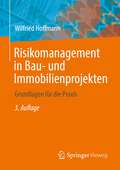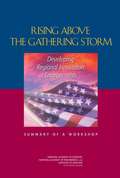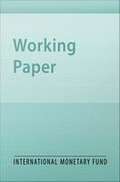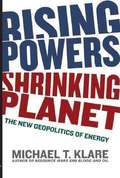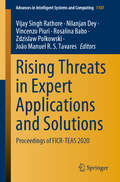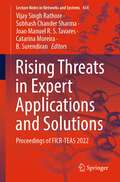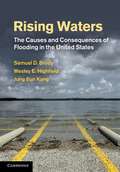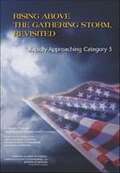- Table View
- List View
Rigid Body Kinematics
by Joaquim A. Batlle Ana Barjau CondominesMaster the conceptual, theoretical and practical aspects of kinematics with this exhaustive text, which provides a rigorous analysis and description of general motion in mechanical systems, with numerous examples from spinning tops to wheel ground-vehicles. Over 400 figures illustrate the main ideas and provide a geometrical interpretation and a deeper understanding of concepts, and exercises and problems throughout the text provide additional hands-on practice. Ideal for students taking courses on rigid body kinematics, and an invaluable reference for researchers.
Rigid-Flexible Coupling Dynamics and Control of Flexible Spacecraft with Time-Varying Parameters
by Jie Wang Dong-Xu LiThis book presents the dynamic modeling and attitude control of flexible spacecraft with time-varying parameters. The dynamic characteristics, vibration control methods and attitude stabilization methods for spacecraft are systematically studied in respects of the theoretical modeling, numerical simulation and the ground experiment.Three active control theories in complex mode space are presented for flexible space structures. Optimal slew strategies based on variable amplitudes input shaping methods and coupling control methods are proposed for stabilization of flexible spacecraft. The research provides an important way to solve the problem of high-precision attitude control of flexible spacecraft with time-varying parameters. This book is appropriate for the researchers who focus on the multi-body dynamics, attitude and vibration control of flexible spacecraft.
Rigor in the Remote Learning Classroom: Instructional Tips and Strategies
by Barbara R. BlackburnLearn how to keep the rigor and motivation alive in a remote learning or hybrid K–12 classroom. In this essential book, bestselling author Barbara R. Blackburn shares frameworks and tools to help you move online without compromising the rigor of your instruction. You’ll learn… how to create a remote culture of high expectations; how to scaffold so students reach higher levels of learning; how to have students collaborate in different settings; and how to provide virtual feedback and deliver effective assessments. You’ll also discover how common activities, such as virtual field trips, can lack rigor without critical thinking prompts. The book provides practical strategies you can implement immediately to help all students reach higher levels of success.
Ring Resonator Systems to Perform Optical Communication Enhancement Using Soliton
by Iraj Sadegh Amiri Abdolkarim AfroozehThe title explain new technique of secured and high capacity optical communication signals generation by using the micro and nano ring resonators. The pulses are known as soliton pulses which are more secured due to having the properties of chaotic and dark soliton signals with ultra short bandwidth. They have high capacity due to the fact that ring resonators are able to generate pulses in the form of solitons in multiples and train form. These pulses generated by ring resonators are suitable in optical communication due to use the compact and integrated rings system, easy to control, flexibility, less loss, application in long distance communication and many other advantages. Using these pulses overcome the problems such as losses during the propagation, long distances, error detection, using many repeaters or amplifiers, undetectable received signals, pulse broadening, overlapping and so on. This book show how to generate soliton pulses using ring resonators in the micro and nano range which can be used in optical communication to improve the transmission technique and quality of received signals in networks such as WiFi and wireless communication.
Rip Currents: Beach Safety, Physical Oceanography, and Wave Modeling
by Stephen Leatherman John FletemeyerRip Currents: Beach Safety, Physical Oceanography, and Wave Modeling is the culmination of research from over 100 coastal scientists, engineers, forecast meteorologists, lifeguard chiefs, and other practitioners from around the world who participated in the 1st International Rip Current Symposium. These experts identify advancements in research tha
Riparian Areas of the Southwestern United States: Hydrology, Ecology, and Management
by Peter F. Ffolliott Malchus B. Baker Leonard F. DeBano Daniel G. NearyThe demand for water resulting from massive population and economic growth in the southwestern U.S. overwhelmed traditional uses of riparian areas. As a consequence, many of these uniquely-structured ecosystems have been altered or destroyed. Within recent years people have become increasingly aware of the many uses and benefits of riparian zones a
Rise of the Machines: A Cybernetic History
by Thomas RidA sweeping history of our deep entanglement with technology. As lives offline and online merge even more, it's easy to forget how we got here. Rise of the Machines reclaims the spectacular story of cybernetics, a control theory of man and machine. In a history that unpacks one of the twentieth century's pivotal ideas, Thomas Rid delivers a thought-provoking portrait of our technology-enraptured era. Springing from the febrile mind of mathematician Norbert Wiener amid the devastation of World War II, the cybernetic vision underpinned a host of seductive myths about the future of machines. This vision would radically transform the postwar world, ushering in sweeping cultural change. From the Cold War's monumental SAGE bomber defense system to enhanced humans, Wiener's scheme turned computers from machines of assured destruction into engines of brilliant utopias. Cybernetics triggered blissful cults, the Whole Earth Catalog, and feminist manifestos, just as it fueled martial gizmos and the air force's foray into virtual space. As Rid shows, cybernetics proved a powerful tool for two competing factions--those who sought to make a better world and those who sought to control the one at hand. In the Bay Area, techno-libertarians embraced networked machines as the portal to a new electronic frontier: a peaceful, open space of freedom. In Washington, DC, cyberspace provided the perfect theater for dominance and war. Meanwhile the future arrived secretly in 1996, with Moonlight Maze, dawn of a new age of digital state-on-state espionage. That "first cyberwar," as Rid reveals in a blow-by-blow account, went on for years--and indeed has never stopped. In our long-promised cybernetic future, the line between utopia and dystopia continues to be disturbingly thin. Drawing on new sources and interviews with hippies, anarchists, sleuths, and spies, Rise of the Machines offers an unparalleled perspective into our anxious embrace of technology and today's clash of digital privacy and security.
Rise of the Red Engineers
by Joel AndreasRise of the Red Engineersexplains the tumultuous origins of the class of technocratic officials who rule China today. In a fascinating account, author Joel Andreas chronicles how two mutually hostile groups-the poorly educated peasant revolutionaries who seized power in 1949 and China's old educated elite-coalesced to form a new dominant class. After dispossessing the country's propertied classes, Mao and the Communist Party took radical measures to eliminate class distinctions based on education, aggravating antagonisms between the new political and old cultural elites. Ultimately, however, Mao's attacks on both groups during the Cultural Revolution spurred inter-elite unity, paving the way-after his death-for the consolidation of a new class that combined their political and cultural resources. This story is told through a case study of Tsinghua University, which-as China's premier school of technology-was at the epicenter of these conflicts and became the party's preferred training ground for technocrats, including many of China's current leaders.
Rise of the Red Hand (The Mechanists #1)
by Olivia ChadhaA rare, searing portrayal of the future of climate change in South Asia. A streetrat turned revolutionary and the disillusioned hacker son of a politician try to take down a ruthlessly technocratic government that sacrifices its poorest citizens to build its utopia. The South Asian Province is split in two. Uplanders lead luxurious lives inside a climate-controlled biodome, dependent on technology and gene therapy to keep them healthy and youthful forever. Outside, the poor and forgotten scrape by with discarded black-market robotics, a society of poverty-stricken cyborgs struggling to survive in slums threatened by rising sea levels, unbreathable air, and deadly superbugs. Ashiva works for the Red Hand, an underground network of revolutionaries fighting the government, which is run by a merciless computer algorithm that dictates every citizen&’s fate. She&’s a smuggler with the best robotic arm and cybernetic enhancements the slums can offer, and her cargo includes the most vulnerable of the city&’s abandoned children. When Ashiva crosses paths with the brilliant hacker Riz-Ali, a privileged Uplander who finds himself embroiled in the Red Hand&’s dangerous activities, they uncover a horrifying conspiracy that the government will do anything to bury. From armed guardians kidnapping children to massive robots flattening the slums, to a pandemic that threatens to sweep through the city like wildfire, Ashiva and Riz-Ali will have to put aside their differences in order to fight the system and save the communities they love from destruction.
Rise of the Red Hand (The\mechanists Ser.)
by Olivia Chadha&“Steeped in elements from real-life South Asian cultures, the worldbuilding is original and intriguing, incorporating dystopian and utopian elements along with current hot issues such as societal inequities, digital surveillance, and technology&’s impact on humanity. . . . [A] strong and intricate story.&” —Kirkus Reviews This 2022 Colorado Book Award Winner is a rare, searing portrayal of the future of climate change in South Asia. A streetrat turned revolutionary and the disillusioned hacker son of a politician try to take down a ruthlessly technocratic government that sacrifices its poorest citizens to build its utopia. The South Asian Province is split in two. Uplanders live in a luxurious, climate-controlled biodome, healthy and artificially youthful forever. Outside, the poor and forgotten scrape by with black-market robotics, in slums threatened by rising sea levels, unbreathable air, and deadly superbugs. Ashiva works for the Red Hand, an underground network of revolutionaries fighting the government, which is run by a merciless computer algorithm. As a smuggler with the best robotic arm and cybernetic enhancements the slums can offer, her cargo includes the city&’s most vulnerable abandoned children. When the brilliant Uplander hacker Riz-Ali stumbles into the Red Hand&’s dangerous activities, he and Ashiva uncover a horrifying conspiracy that the government will do anything to bury. As armed guardians kidnap children, massive robots flatten the slums, and a pandemic threatens to decimate the city, Ashiva and Riz must put aside their differences to fight the system and save the communities they love.
Rise of the Robots: Technology and the Threat of a Jobless Future
by Martin FordWhat are the jobs of the future? How many will there be? And who will have them? We might imagine-and hope-that today’s industrial revolution will unfold like the last: even as some jobs are eliminated, more will be created to deal with the new innovations of a new era. In Rise of the Robots, Silicon Valley entrepreneur Martin Ford argues that this is absolutely not the case. As technology continues to accelerate and machines begin taking care of themselves, fewer people will be necessary. Artificial intelligence is already well on its way to making "good jobs” obsolete: many paralegals, journalists, office workers, and even computer programmers are poised to be replaced by robots and smart software. As progress continues, blue and white collar jobs alike will evaporate, squeezing working- and middle-class families ever further. At the same time, households are under assault from exploding costs, especially from the two major industries-education and health care-that, so far, have not been transformed by information technology. The result could well be massive unemployment and inequality as well as the implosion of the consumer economy itself. In Rise of the Robots, Ford details what machine intelligence and robotics can accomplish, and implores employers, scholars, and policy makers alike to face the implications. The past solutions to technological disruption, especially more training and education, aren’t going to work, and we must decide, now, whether the future will see broad-based prosperity or catastrophic levels of inequality and economic insecurity. Rise of the Robots is essential reading for anyone who wants to understand what accelerating technology means for their own economic prospects-not to mention those of their children-as well as for society as a whole.
Rise of the Rocket Girls: The Women Who Propelled Us, from Missiles to the Moon to Mars
by Nathalia HoltThe riveting true story of the women who launched America into space. In the 1940s and 50s, when the newly minted Jet Propulsion Laboratory needed quick-thinking mathematicians to calculate velocities and plot trajectories, they didn't turn to male graduates. <P><P>Rather, they recruited an elite group of young women who, with only pencil, paper, and mathematical prowess, transformed rocket design, helped bring about the first American satellites, and made the exploration of the solar system possible. <P><P> For the first time, Rise of the Rocket Girls tells the stories of these women--known as "human computers"--who broke the boundaries of both gender and science. Based on extensive research and interviews with all the living members of the team, Rise of the Rocket Girls offers a unique perspective on the role of women in science: both where we've been, and the far reaches of space to which we're heading.
Risiko Energiewende
by Konrad KleinknechtDer Ausstieg aus der Nutzung der Kernenergie in Deutschland wurde im Sommer 2011 im Eiltempo beschlossen. Jetzt zeigt sich, dass es keinen realistischen Plan für den Umbau der Energieversorgung in der vorgesehenen Frist von zehn Jahren gibt. Für die Umstellung unserer gesamten Stromversorgung und damit unserer Wirtschaft ist der Zeitraum zu kurz. Es fehlt eine belastbare empirische Begründung, die Fragen der Versorgungssicherheit, der Finanzierbarkeit, der Auswirkungen auf die wirtschaftliche Entwicklung und die soziale Gerechtigkeit behandeln müsste. Somit droht diese Wende an ihren Widersprüchen zu scheitern. Konrad Kleinknecht versucht in seinem Buch, die Probleme zu benennen und Antworten zu finden. Für ihn stellen sich die folgenden Fragen: Welche Möglichkeit haben wir, mit Windkraft und Solarenergie einen Teil der Stromversorgung zu ersetzen? Welche Stromquellen bieten gesicherte Leistung? Können wir auf Kohlekraftwerke verzichten? Brauchen wir neue Stromtrassen? Wie lässt sich Strom speichern? Wie real ist die Gefahr eines Blackouts in windstillen Nächten? Werden die Strompreise weiter steigen? Lassen sich mit einer grundlegenden Reform des Erneuerbare-Energien-Gesetzes (EEG) die großen Risiken der Energiewende noch vermeiden? Die Energieversorgung muss dem Wohl des Ganzen dienen und dem Industriestandort Deutschland nutzen. Ein Blackout wäre eine Katastrophe für das ganze Land, er muss unter allen Umständen vermieden werden. Wie wir dies bewerkstelligen können, vermittelt der Autor in seinem aufrüttelndem Buch.
Risikobeurteilung von Mensch-Roboter-Koexistenz-Systemen: Ansätze für ein erweitertes Bewertungsverfahren zur Sicherstellung der Maschinensicherheit (BestMasters)
by Dominik PuschIn der heutigen industriellen Produktion werden neue, flexibel einsetzbare Unterstützungssysteme notwendig, wie sie beispielsweise hybride Montagesysteme in Form von Leichtbaurobotern bieten. Der Einsatz solcher Systeme stellt dabei erhebliche Anforderungen an die Maschinensicherheit. Dies führt häufig zu einem Konflikt zwischen Produktivität und Sicherheit der Anwendung. Die nicht ausreichende Differenzierung zwischen Leichtbau- und Industrieroboter stellt dabei die größte Herausforderung dar, weshalb für die Interaktionsform der Koexistenz eine erweiterte Bewertungsmethodik erarbeitet wurde. Diese ermöglicht es, den normativen Sicherheitsabstand ohne Kompromittierung der Sicherheit zu reduzieren, um das volle Potential der neuen Technologie auszuschöpfen.
Risikologische Wirksamkeitsanalyse: Ein methodischer Beitrag zur Beurteilung von Schutzmaßnahmen
by Sebastian FestagFür die Auseinandersetzung mit Gefährdungen gibt es methodische und systematische Vorgehensweisen. Werden Schutzmaßnahmen gegen Gefährdungen ergriffen, so ist deren Wirksamkeit zu überprüfen. Hierfür gibt es nur wenige Orientierungspunkte und methodische Standards. In der Praxis wird der Wirksamkeitskontrolle häufig nicht ausreichend Aufmerksamkeit geschenkt. Folglich existieren Schutzmaßnahmen mit einer ganzen Bandbreite von Wirkungen, von hochwirksam bis zu kontraproduktiv. Die Wirksamkeit einer Maßnahme lässt sich über die Wirksamkeitskontrolle ermitteln. Die vorliegende Arbeit fasst die zu beachtenden Grundlagen zusammen und liefert ein methodisches Fundament zur empirischen Durchführung solcher Kontrollen, um über einen methodischen Querschnittsbeitrag die Reduzierung von Gefährdungen zu unterstützen. Nach der theoretischen Hinführung in die Thematik der Wirksamkeitskontrolle wird die praktische Durchführung anhand von unterschiedlichen Schutzmaßnahmen in verschiedenen Anwendungsbereichen demonstriert. Mit diesen Fallanalysen wird die Bandbreite der Optionen zur Bewertung der Wirksamkeit abgebildet. Darauf basierend werden die wesentlichen Linien zur Weiterentwicklung der Wirksamkeitskontrolle beschrieben.
Risikomanagement bei Public Private Partnerships
by Andreas Pfnür Christoph Schetter Henning SchöbenerDer Band beschäftigt sich mit dem Risikomangement bei öffentlichen Infrastrukturinvestitionen, insbesondere bei öffentlich-privaten Partnerschaften. Dabei legen die Autoren großen Wert auf Verständlichkeit und praktischen Nutzen: Leser sollen befähigt werden, Risikoidentifikation und -bewertung sowie das Risikomanagement selbst durchzuführen. Dabei wird der gesamte Lebenszyklus der Investition betrachtet, Verfahren der simulativen Risikoanalyse diskutiert sowie die Möglichkeiten und Grenzen des Handels mit Projektrisiken am Kapitalmarkt ausgelotet.
Risikomanagement in Bau- und Immobilienprojekten: Grundlagen für die Praxis
by Wilfried HoffmannDas Buch erläutert übersichtlich, was sich hinter dem Begriff "Risikomanagement" verbirgt. Es liefert zudem Handlungsempfehlungen und -anleitungen. Bauprojekte werden von unterschiedlichen Risiken begleitet, die sich auf die gesteckten Ziele auswirken können. Um die zu Projektbeginn definierten Ziele am Ende des Projekts auch wirklich zu erreichen, sind regelmäßig Entscheidungen zu treffen. Eine zielführende Entscheidung kann jedoch nur dann mit großer Sicherheit getroffen werden, wenn alle Abhängigkeiten bekannt sind. Sind den Projektbeteiligten diese Abhängigkeiten unbekannt, bestehen Unsicherheiten, die sich aus einem Anteil Ungewissheit (Wagnis) und einem Anteil Risiken zusammensetzen. Die Risiken lassen sich je nach Ausprägung als Gefahren (negative Zielerreichung) oder aber als Chancen (positive Zielabweichung) darstellen. Ein im Projekt etabliertes Risikomanagement hilft, die immanenten Risiken maßgeblich zu minimieren. Es kann die negativen Abweichungen in den Projektprozessen optimieren und einen Mittelweg zwischen Gefahren und Chancen austarieren.
Rising Above the Gathering Storm
by Institute of Medicine Steve Olson National Academy Of Sciences National Academy of Engineering Committee on Science, Engineering, and Public Policy Tom ArrisonIn October 2005, the National Academy of Sciences, National Academy of Engineering, and Institute of Medicine released a policy report that served as a call to action. The report, Rising Above the Gathering Storm: Energizing and Employing America for a Brighter Economic Future observed that "the scientific and technological building blocks critical to the United States economic leadership are eroding at a time when many other nations are gathering strength." The report laid out 20 recommendations in four broad areas - K-12 education, science and engineering research, higher education, and economic and technology policy - and warned that a failure to take action could have dire economic consequences. Rising Above the Gathering Storm sparked intense discussion among policy makers, industrial leaders, and the general public. Five years after the release of the Gathering Storm report, a second report, Rising Above the Gathering Storm, Revisited: Rapidly Approaching Category 5, assessed changes in America's competitive posture. This report concluded that "our nation's outlook has not improved, but rather has worsened" since the Gathering Storm report was released. The report noted examples of other nations that have upgraded their investments in education, technological infrastructure, and innovation systems to a greater extent than has the United States. The ability of the states to drive innovation was the impetus behind a major workshop held in Madison, Wisconsin, on September 20-22, 2011. Titled "Rising Above the Gathering Storm: Developing Regional Innovation Environments," the workshop brought together leaders in education, government, economic development, and industrial innovation to discuss state and regional initiatives to boost competitiveness through science, technology, and innovation. The conference was organized around four major themes: - Revitalizing K-12 Science and Mathematics Education - Strengthening Undergraduate Education in Science and Engineering - Building Effective Partnerships Among Governments, Universities, Companies, and Other Stakeholders - Fostering Regional Technology Development and Entrepreneurship Rising Above the Gathering Storm: Developing Regional Innovation Environments: A Workshop Summary gives an overview of the presentations, observations, and recommendations made during the workshop.
Rising Income Inequality: Technology, or Trade and Financial Globalization?
by Florence Jaumotte Subir Lall Chris PapageorgiouA report from the International Monetary Fund.
Rising Powers, Shrinking Planet: The New Geopolitics of Energy
by Michael T. KlareFrom the author of the now-classic Resource Wars, an indispensable account of how the world's diminishing sources of energy are radically changing the international balance of power Recently, an unprecedented Chinese attempt to acquire the major American energy firm Unocal was blocked by Congress amidst hysterical warnings of a Communist threat. But the political grandstanding missed a larger point: the takeover bid was a harbinger of a new structure of world power, based not on market forces or on arms and armies but on the possession of vital natural resources. Surveying the energy-driven dynamic that is reconfiguring the international landscape, Michael Klare, the preeminent expert on resource geopolitics, forecasts a future of surprising new alliances and explosive danger. World leaders are now facing the stark recognition that all materials vital for the functioning of modern industrial societies (not just oil and natural gas but uranium, coal, copper, and others) are finite and being depleted at an ever-accelerating rate. As a result, governments rather than corporations are increasingly spearheading the pursuit of resources. In a radically altered world--where Russia is transformed from battered Cold War loser to arrogant broker of Eurasian energy, and the United States is forced to compete with the emerging "Chindia" juggernaut--the only route to survival on a shrinking planet, Klare shows, lies through international cooperation.
Rising Threats in Expert Applications and Solutions: Proceedings of FICR-TEAS 2020 (Advances in Intelligent Systems and Computing #1187)
by Vincenzo Piuri João Manuel R. S. Tavares Nilanjan Dey Rosalina Babo Vijay Singh Rathore Zdzislaw PolkowskiThis book presents high-quality, peer-reviewed papers from the FICR International Conference on Rising Threats in Expert Applications and Solutions 2020, held at IIS University Jaipur, Rajasthan, India, on January 17–19, 2020. Featuring innovative ideas from researchers, academics, industry professionals and students, the book covers a variety of topics, including expert applications and artificial intelligence/machine learning; advanced web technologies, like IoT, big data, and cloud computing in expert applications; information and cybersecurity threats and solutions; multimedia applications in forensics, security and intelligence; advances in app development; management practices for expert applications; and social and ethical aspects of expert applications in applied sciences.
Rising Threats in Expert Applications and Solutions: Proceedings of FICR-TEAS 2022 (Lecture Notes in Networks and Systems #434)
by Vijay Singh Rathore Subhash Chander Sharma Joao Manuel R. S. Tavares Catarina Moreira B. SurendiranThe book presents high-quality, peer-reviewed papers from the FICR International Conference on Rising Threats in Expert Applications and Solutions 2022 organized by IIS (Deemed to be University), Jaipur, Rajasthan, India, during January 7–8, 2022. The volume is a collection of innovative ideas from researchers, scientists, academicians, industry professionals, and students. The book covers a variety of topics, such as expert applications and artificial intelligence/machine learning; advance web technologies such as IoT, big data, cloud computing in expert applications; information and cyber security threats and solutions, multimedia applications in forensics, security and intelligence; advancements in app development; management practices for expert applications; and social and ethical aspects in expert applications through applied sciences.
Rising Waters
by Samuel D. Brody Wesley E. Highfield Jung Eun KangIn the wake of Hurricane Katrina and the flooding of New Orleans in 2005, this interdisciplinary book brings together five years of empirical research funded by the National Science Foundation. It explores the causes of flooding in the United States and the ways in which local communities can reduce the associated human casualties and property damage. Focussing on Texas and Florida, the authors investigate factors other than rainfall that determine the degree of flooding, and consider the key role of non-structural techniques and strategies in flood mitigation. The authors present an empirical and multi-scale assessment that underlines the critical importance of local planning and development decisions. Written for advanced students and researchers in hazard mitigation, hydrology, geography, environmental planning and public policy, this book will also provide policy makers, government employees and engineers with important insights into how to make their communities more resilient to the adverse impacts of flooding.
Rising above the Gathering Storm, Revisited: Rapidly Approaching Category 5
by National Academy Of Sciences National Academy of Engineering Institute of Medicine of the National AcademiesIn the face of so many daunting near-term challenges,U.S. government and industry are letting the crucial strategic issues of U.S. competitiveness slip below the surface. Five years ago,the National Academies prepared Rising Above the Gathering Storm,a book that cautioned: "Without a renewed effort to bolster the foundations of our competitiveness,we can expect to lose our privileged position." Since that time we find ourselves in a country where much has changed--and a great deal has not changed. So where does America stand relative to its position of five years ago when the Gathering Storm book was prepared? The unanimous view of the authors is that our nation's outlook has worsened. The present volume,Rising Above the Gathering Storm,Revisited,explores the tipping point America now faces. Addressing America's competitiveness challenge will require many years if not decades; however,the requisite federal funding of much of that effort is about to terminate. Rising Above the Gathering Storm,Revisited provides a snapshot of the work of the government and the private sector in the past five years,analyzing how the original recommendations have or have not been acted upon,what consequences this may have on future competitiveness,and priorities going forward. In addition,readers will find a series of thought- and discussion-provoking factoids--many of them alarming--about the state of science and innovation in America. Rising Above the Gathering Storm,Revisited is a wake-up call. To reverse the foreboding outlook will require a sustained commitment by both individual citizens and government officials--at all levels. This book,together with the original Gathering Storm volume,provides the roadmap to meet that goal. While this book is essential for policy makers,anyone concerned with the future of innovation,competitiveness,and the standard of living in the United States will find this book an ideal tool for engaging their government representatives,peers,and community about this momentous issue.
Risk & Innovation: The Role and Importance of Small High-Tech Companies in the U.S. Economy
by Committee on Technology Management Capital in Small High-Tech CompaniesSmaller, technically-oriented companies often assume types of risk (and an amount of risk) that is not often tolerated by large companies. In the United States both consumers and companies depend on smaller, high-tech companies to explore the commercial application of technology in potential, emerging, and small markets. This book, through comparison of six industries in which small companies play a critical role, explores the principal economic function of small, high-tech companies--to probe, explore, and sometimes develop the frontiers of the U.S. economy in search of unrecognized or otherwise ignored opportunities for economic growth and development.
